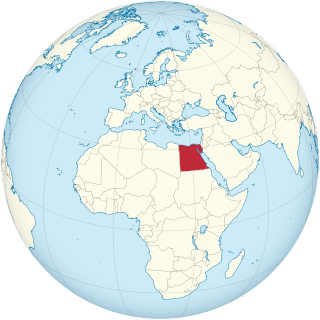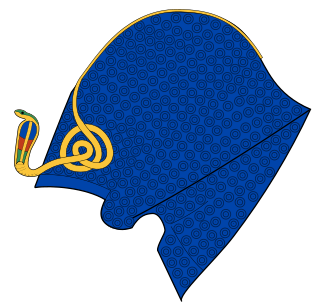Purpose
Its purpose might have been to reminisce on Egypt's old glory during foreign Persian or Ptolemaic rule, or to glorify Khonsu-Neferhotep, "the merciful" and Khonsu-Pairsekher, "the provider", the two aspects of the god worshiped in Thebes, or was inspired by the rivalry of their respective priesthoods. [2] : 90
The alleged marriage between Ramesses II and the daughter of the prince of Bactria has recently been interpreted as an example of imitatio alexandri, i.e. the imitation of Alexander the Great. [1] : 67ff
Description
The stela is made of black sandstone; its proportions are 222×109 cm. It was found in 1829 in a small Ptolemaic shrine that stood next to the Khonsu temple of Ramesses III in Karnak. It is now in the Louvre (Louvre C 284). [2] : 90 [1] : 65
Lunette
The lunette shows Ramesses II giving incense offerings to Khonsu of Thebes.
Text
The text consists of 28 lines, [2] : 90 begins with the titles of Ramesses, then recounts the story: When His Majesty traveled to Naharin, the Prince of Bakhtan gave him his eldest daughter in marriage. The pharaoh named the girl Neferure (she was possibly modeled on Ramesses' foreign Great Royal Wife Maathorneferure) and made her his queen. In the 23rd regnal year the Pharaoh received news that Neferure's younger sister Bentresh became ill. Ramesses sent her the wise scribe Djehutyemheb to heal her, but he didn't succeed, because the girl was seized by a demon. The Prince of Bakhtan asked the Pharaoh to send a god. Ramesses asked the help of Khonsu-Neferhotep who gave his magical protection to Khonsu-Pairsekher, whose statue was then dispatched to Bakhtan. The god expelled the demon and healed the princess. The Prince of Bakhtan failed to send the god back to Egypt, thus Khonsu spent 3 years and 9 months in Bakhtan, but one night the Prince saw a dream: the god changed into a golden falcon, left his shrine and flew back to Egypt. The Prince understood that he had to let the god go, and ordered the statue to be taken back to Egypt. [2] : 91–94
The story of Bentresh has been suggested to have inspired the Christian Legend of Hilaria . [3] There are, however, major differences between the two stories.
Montu was a falcon-god of war in the ancient Egyptian religion, an embodiment of the conquering vitality of the pharaoh. He was particularly worshipped in Upper Egypt and in the district of Thebes.
[Ramesses II] whom victory was foretold as he came from the womb,
Whom valor was given while in the egg,
Bull firm of heart as he treads the arena,
Godly king going forth like Montu on victory day.

Articles related to Egypt include:

Kamose was the last Pharaoh of the Theban Seventeenth Dynasty. He was possibly the son of Seqenenre Tao and Ahhotep I and the brother of Ahmose I, founder of the Eighteenth Dynasty. His reign fell at the very end of the Second Intermediate Period. Kamose is usually ascribed a reign of three years, although some scholars now favor giving him a longer reign of approximately five years.

Userkare Khendjer was a minor king of the early Thirteenth Dynasty of Egypt during the Middle Kingdom. Khendjer possibly reigned for four to five years, archaeological attestations show that he was on the throne for at least three or four years three months and five days. Khendjer had a small pyramid built for himself in Saqqara and it is therefore likely that his capital was in Memphis.

Djedhotepre Dedumose I was an Egyptian pharaoh of the Second Intermediate Period. According to egyptologists Kim Ryholt, Darrell Baker, Aidan Dodson and Dyan Hilton, he was a king of the 16th Dynasty. Alternatively, Jürgen von Beckerath, Thomas Schneider and Detlef Franke see him as a king of the 13th Dynasty.

Maathorneferure was an ancient Egyptian queen, the Great Royal Wife of Ramesses II.

Khasekhemre Neferhotep I was an Egyptian pharaoh of the mid Thirteenth Dynasty ruling in the second half of the 18th century BC during a time referred to as the late Middle Kingdom or early Second Intermediate Period, depending on the scholar. One of the best attested rulers of the 13th Dynasty, Neferhotep I reigned for 11 years.

Khutawyre Wegaf was a pharaoh of the early Thirteenth Dynasty of Egypt in the late Middle Kingdom/Second Intermediate Period. He is known from several sources, including a stele and statues. In the Turin King List he is the first ruler of this dynasty with a reign of 2 regnal years.

Khaneferre Sobekhotep IV was one of the more powerful Egyptian kings of the 13th Dynasty, who reigned at least eight years. His brothers, Neferhotep I and Sihathor, were his predecessors on the throne, the latter having only ruled as coregent for a few months.

Isetnofret was one of the Great Royal Wives of Pharaoh Ramesses II and was the mother of his successor, Merneptah. She was one of the most prominent of the royal wives, along with Nefertari, and was the chief queen after Nefertari's death.

Sekhemre Sewadjtawy Sobekhotep III was an Egyptian king of the mid Thirteenth Dynasty of Egypt who reigned three to four years.

The khepresh (ḫprš) was an ancient Egyptian royal headdress. It is also known as the blue crown or war crown. New Kingdom pharaohs are often depicted wearing it in battle, but it was also frequently worn in ceremonies. While it was once called the war crown by many, modern historians refrain from characterizing it thus.

Seuserenre Bebiankh was a king in Upper Egypt during the Second Intermediate Period. He is often placed in the 16th Theban Dynasty and his prenomen is mentioned in the Turin King List with a reign of 12 years.
Sewadjenre Nebiryraw was an ancient Egyptian pharaoh of the Theban-based 16th Dynasty, during the Second Intermediate Period.

Sekhemre Sankhtawy Neferhotep III Iykhernofret was the third or fourth ruler of the Theban 16th Dynasty, reigning after Sobekhotep VIII according to Egyptologists Kim Ryholt and Darrell Baker. He is assigned a reign of 1 year in the Turin Canon and is known primarily by a single stela from Thebes. In an older study, Jürgen von Beckerath dated Neferhotep III to the end of the 13th Dynasty.
This page list topics related to ancient Egypt.

Seheqenre Sankhptahi was a pharaoh of the late 13th Dynasty, possibly the fifty-fourth or fifty-fifth king of this dynasty. He most likely reigned for a short period over the Memphite region during the mid-17th century BC, some time between 1663 BC and 1649 BC.

Seth Meribre was an Ancient Egyptian petty king during the early 13th Dynasty during the late Middle Kingdom.

Menkhaure Snaaib was an Egyptian pharaoh during the Second Intermediate Period between the Middle Kingdom and New Kingdom at the end of the Middle Bronze Age.

The Department of Egyptian Antiquities of the Louvre is a department of the Louvre that is responsible for artifacts from the Nile civilizations which date from 4,000 BC to the 4th century. The collection, comprising over 50,000 pieces, is among the world's largest, overviews Egyptian life spanning Ancient Egypt, the Middle Kingdom, the New Kingdom, Coptic art, and the Roman, Ptolemaic, and Byzantine periods.
This page is based on this
Wikipedia article Text is available under the
CC BY-SA 4.0 license; additional terms may apply.
Images, videos and audio are available under their respective licenses.

















